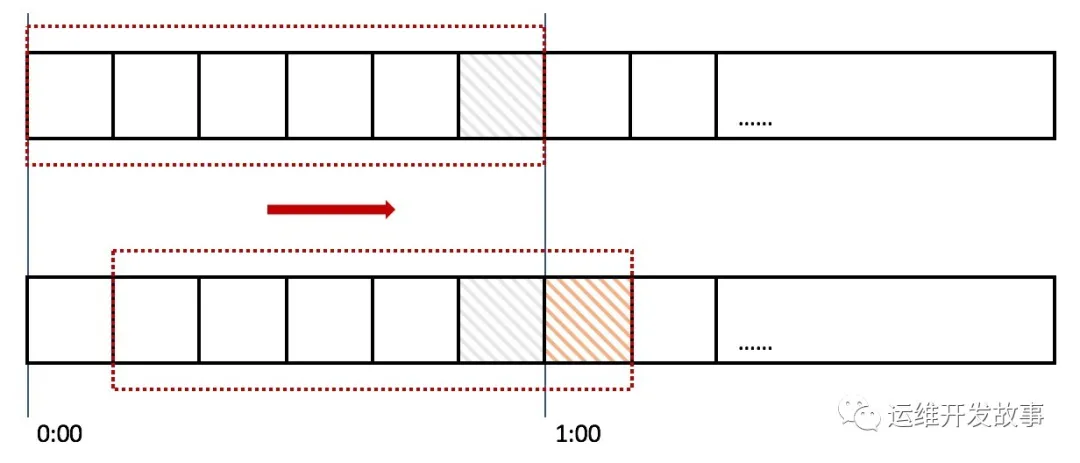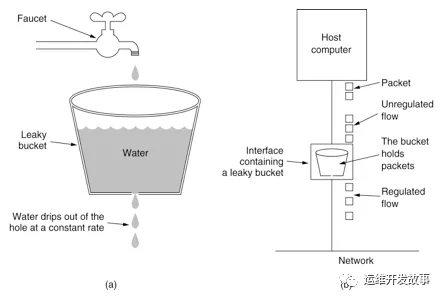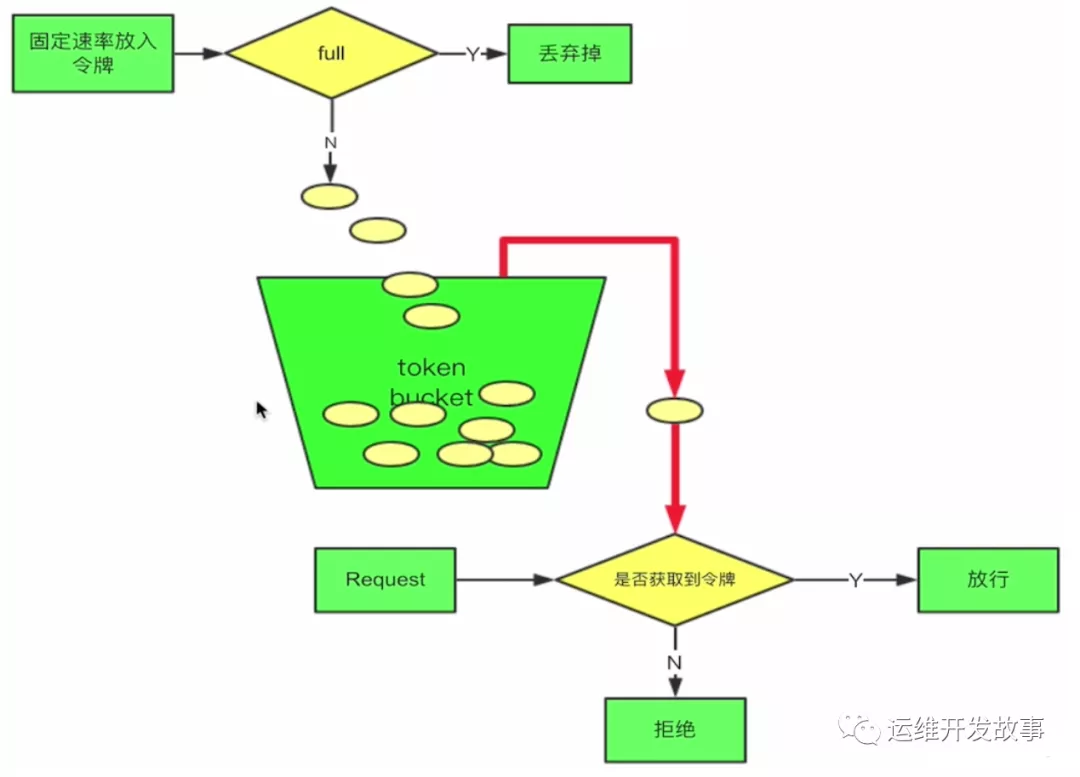一篇帶給你 Sentinel 和常用流控算法
本文主要講述常見的幾種限流算法:計數器算法、漏桶算法、令牌桶算法。然后結合我對 Sentinel 1.8.0 的理解,給大家分享 Sentinel 在源碼中如何使用這些算法進行流控判斷。
計數器限流算法
我們可以直接通過一個計數器,限制每一秒鐘能夠接收的請求數。比如說 qps定為 1000,那么實現思路就是從第一個請求進來開始計時,在接下去的 1s 內,每來一個請求,就把計數加 1,如果累加的數字達到了 1000,那么后續的請求就會被全部拒絕。等到 1s 結束后,把計數恢復成 0 ,重新開始計數。
優點:實現簡單
缺點:如果1s 內的前半秒,已經通過了 1000 個請求,那后面的半秒只能請求拒絕,我們把這種現象稱為“突刺現象”。
實現代碼案例:
- public class Counter {
- public long timeStamp = getNowTime();
- public int reqCount = 0;
- public final int limit = 100; // 時間窗口內最大請求數
- public final long interval = 1000; // 時間窗口ms
- public boolean limit() {
- long now = getNowTime();
- if (now < timeStamp + interval) {
- // 在時間窗口內
- reqCount++;
- // 判斷當前時間窗口內是否超過最大請求控制數
- return reqCount <= limit;
- } else {
- timeStamp = now;
- // 超時后重置
- reqCount = 1;
- return true;
- }
- }
- public long getNowTime() {
- return System.currentTimeMillis();
- }
- }
滑動時間窗算法
滑動窗口,又稱 Rolling Window。為了解決計數器算法的缺陷,我們引入了滑動窗口算法。下面這張圖,很好地解釋了滑動窗口算法:
在上圖中,整個紅色的矩形框表示一個時間窗口,在我們的例子中,一個時間窗口就是一分鐘。然后我們將時間窗口進行劃分,比如圖中,我們就將滑動窗口 劃成了6格,所以每格代表的是10秒鐘。每過10秒鐘,我們的時間窗口就會往右滑動一格。每一個格子都有自己獨立的計數器counter,比如當一個請求 在0:35秒的時候到達,那么0:30~0:39對應的counter就會加1。
那么滑動窗口怎么解決剛才的臨界問題的呢?我們可以看上圖,0:59到達的100個請求會落在灰色的格子中,而1:00到達的請求會落在橘黃色的格子中。當時間到達1:00時,我們的窗口會往右移動一格,那么此時時間窗口內的總請求數量一共是200個,超過了限定的100個,所以此時能夠檢測出來觸發了限流。
我再來回顧一下剛才的計數器算法,我們可以發現,計數器算法其實就是滑動窗口算法。只是它沒有對時間窗口做進一步地劃分,所以只有1格。
由此可見,當滑動窗口的格子劃分的越多,那么滑動窗口的滾動就越平滑,限流的統計就會越精確。
實現代碼案例:
- public class SlideWindow {
- /** 隊列id和隊列的映射關系,隊列里面存儲的是每一次通過時候的時間戳,這樣可以使得程序里有多個限流隊列 */
- private volatile static Map<String, List<Long>> MAP = new ConcurrentHashMap<>();
- private SlideWindow() {}
- public static void main(String[] args) throws InterruptedException {
- while (true) {
- // 任意10秒內,只允許2次通過
- System.out.println(LocalTime.now().toString() + SlideWindow.isGo("ListId", 2, 10000L));
- // 睡眠0-10秒
- Thread.sleep(1000 * new Random().nextInt(10));
- }
- }
- /**
- * 滑動時間窗口限流算法
- * 在指定時間窗口,指定限制次數內,是否允許通過
- *
- * @param listId 隊列id
- * @param count 限制次數
- * @param timeWindow 時間窗口大小
- * @return 是否允許通過
- */
- public static synchronized boolean isGo(String listId, int count, long timeWindow) {
- // 獲取當前時間
- long nowTime = System.currentTimeMillis();
- // 根據隊列id,取出對應的限流隊列,若沒有則創建
- List<Long> list = MAP.computeIfAbsent(listId, k -> new LinkedList<>());
- // 如果隊列還沒滿,則允許通過,并添加當前時間戳到隊列開始位置
- if (list.size() < count) {
- list.add(0, nowTime);
- return true;
- }
- // 隊列已滿(達到限制次數),則獲取隊列中最早添加的時間戳
- Long farTime = list.get(count - 1);
- // 用當前時間戳 減去 最早添加的時間戳
- if (nowTime - farTime <= timeWindow) {
- // 若結果小于等于timeWindow,則說明在timeWindow內,通過的次數大于count
- // 不允許通過
- return false;
- } else {
- // 若結果大于timeWindow,則說明在timeWindow內,通過的次數小于等于count
- // 允許通過,并刪除最早添加的時間戳,將當前時間添加到隊列開始位置
- list.remove(count - 1);
- list.add(0, nowTime);
- return true;
- }
- }
- }
在 Sentinel 中 通過 LeapArray 結構來實現時間窗算法, 它的核心代碼如下(只列舉獲取時間窗方法):
- /**
- * 獲取當前的時間窗
- *
- * Get bucket item at provided timestamp.
- *
- * @param timeMillis a valid timestamp in milliseconds
- * @return current bucket item at provided timestamp if the time is valid; null if time is invalid
- */
- public WindowWrap<T> currentWindow(long timeMillis) {
- if (timeMillis < 0) {
- return null;
- }
- int idx = calculateTimeIdx(timeMillis);
- // Calculate current bucket start time.
- // 計算窗口的開始時間,計算每個格子的開始時間
- long windowStart = calculateWindowStart(timeMillis);
- /*
- * Get bucket item at given time from the array.
- *
- * (1) Bucket is absent, then just create a new bucket and CAS update to circular array.
- * (2) Bucket is up-to-date, then just return the bucket.
- * (3) Bucket is deprecated, then reset current bucket and clean all deprecated buckets.
- */
- while (true) {
- WindowWrap<T> old = array.get(idx);
- // 如果沒有窗格,創建窗格
- if (old == null) {
- /*
- * B0 B1 B2 NULL B4
- * ||_______|_______|_______|_______|_______||___
- * 200 400 600 800 1000 1200 timestamp
- * ^
- * time=888
- * bucket is empty, so create new and update
- *
- * If the old bucket is absent, then we create a new bucket at {@code windowStart},
- * then try to update circular array via a CAS operation. Only one thread can
- * succeed to update, while other threads yield its time slice.
- */
- WindowWrap<T> window = new WindowWrap<T>(windowLengthInMs, windowStart, newEmptyBucket(timeMillis));
- if (array.compareAndSet(idx, null, window)) {
- // Successfully updated, return the created bucket.
- return window;
- } else {
- // Contention failed, the thread will yield its time slice to wait for bucket available.
- Thread.yield();
- }
- // 當前窗格存在,返回歷史窗格
- } else if (windowStart == old.windowStart()) {
- /*
- * B0 B1 B2 B3 B4
- * ||_______|_______|_______|_______|_______||___
- * 200 400 600 800 1000 1200 timestamp
- * ^
- * time=888
- * startTime of Bucket 3: 800, so it's up-to-date
- *
- * If current {@code windowStart} is equal to the start timestamp of old bucket,
- * that means the time is within the bucket, so directly return the bucket.
- */
- return old;
- //
- } else if (windowStart > old.windowStart()) {
- /*
- * (old)
- * B0 B1 B2 NULL B4
- * |_______||_______|_______|_______|_______|_______||___
- * ... 1200 1400 1600 1800 2000 2200 timestamp
- * ^
- * time=1676
- * startTime of Bucket 2: 400, deprecated, should be reset
- *
- * If the start timestamp of old bucket is behind provided time, that means
- * the bucket is deprecated. We have to reset the bucket to current {@code windowStart}.
- * Note that the reset and clean-up operations are hard to be atomic,
- * so we need a update lock to guarantee the correctness of bucket update.
- *
- * The update lock is conditional (tiny scope) and will take effect only when
- * bucket is deprecated, so in most cases it won't lead to performance loss.
- */
- if (updateLock.tryLock()) {
- try {
- // Successfully get the update lock, now we reset the bucket.
- // 清空所有的窗格數據
- return resetWindowTo(old, windowStart);
- } finally {
- updateLock.unlock();
- }
- } else {
- // Contention failed, the thread will yield its time slice to wait for bucket available.
- Thread.yield();
- }
- // 如果時鐘回撥,重新創建時間格
- } else if (windowStart < old.windowStart()) {
- // Should not go through here, as the provided time is already behind.
- return new WindowWrap<T>(windowLengthInMs, windowStart, newEmptyBucket(timeMillis));
- }
- }
- }
漏桶算法
漏桶算法(Leaky Bucket)是網絡世界中流量整形(Traffic Shaping)或速率限制(Rate Limiting)時經常使用的一種算法,它的主要目的是控制數據注入到網絡的速率,平滑網絡上的突發流量。漏桶算法提供了一種機制,通過它,突發流量可以被整形以便為網絡提供一個穩定的流量, 執行過程如下圖所示。
實現代碼案例:
- public class LeakyBucket {
- public long timeStamp = System.currentTimeMillis(); // 當前時間
- public long capacity; // 桶的容量
- public long rate; // 水漏出的速度
- public long water; // 當前水量(當前累積請求數)
- public boolean grant() {
- long now = System.currentTimeMillis();
- // 先執行漏水,計算剩余水量
- water = Math.max(0, water - (now - timeStamp) * rate);
- timeStamp = now;
- if ((water + 1) < capacity) {
- // 嘗試加水,并且水還未滿
- water += 1;
- return true;
- } else {
- // 水滿,拒絕加水
- return false;
- }
- }
- }
說明:
(1)未滿加水:通過代碼 water +=1進行不停加水的動作。
(2)漏水:通過時間差來計算漏水量。
(3)剩余水量:總水量-漏水量。
在 Sentine 中RateLimiterController 實現了了漏桶算法 , 核心代碼如下
- @Override
- public boolean canPass(Node node, int acquireCount, boolean prioritized) {
- // Pass when acquire count is less or equal than 0.
- if (acquireCount <= 0) {
- return true;
- }
- // Reject when count is less or equal than 0.
- // Otherwise,the costTime will be max of long and waitTime will overflow in some cases.
- if (count <= 0) {
- return false;
- }
- long currentTime = TimeUtil.currentTimeMillis();
- // Calculate the interval between every two requests.
- // 計算時間間隔
- long costTime = Math.round(1.0 * (acquireCount) / count * 1000);
- // Expected pass time of this request.
- // 期望的執行時間
- long expectedTime = costTime + latestPassedTime.get();
- // 當前時間 > 期望時間
- if (expectedTime <= currentTime) {
- // Contention may exist here, but it's okay.
- // 可以通過,并且設置最后通過時間
- latestPassedTime.set(currentTime);
- return true;
- } else {
- // Calculate the time to wait.
- // 等待時間 = 期望時間 - 最后時間 - 當前時間
- long waitTime = costTime + latestPassedTime.get() - TimeUtil.currentTimeMillis();
- // 等待時間 > 最大排隊時間
- if (waitTime > maxQueueingTimeMs) {
- return false;
- } else {
- // 上次時間 + 間隔時間
- long oldTime = latestPassedTime.addAndGet(costTime);
- try {
- // 等待時間
- waitTime = oldTime - TimeUtil.currentTimeMillis();
- // 等待時間 > 最大排隊時間
- if (waitTime > maxQueueingTimeMs) {
- latestPassedTime.addAndGet(-costTime);
- return false;
- }
- // in race condition waitTime may <= 0
- // 休眠等待
- if (waitTime > 0) {
- Thread.sleep(waitTime);
- }
- // 等待完了,就放行
- return true;
- } catch (InterruptedException e) {
- }
- }
- }
- return false;
- }
令牌桶算法
令牌桶算法是網絡流量整形(Traffic Shaping)和速率限制(Rate Limiting)中最常使用的一種算法。典型情況下,令牌桶算法用來控制發送到網絡上的數據的數目,并允許突發數據的發送。如下圖所示:
簡單的說就是,一邊請求時會消耗桶內的令牌,另一邊會以固定速率往桶內放令牌。當消耗的請求大于放入的速率時,進行相應的措施,比如等待,或者拒絕等。
實現代碼案例:
- public class TokenBucket {
- public long timeStamp = System.currentTimeMillis(); // 當前時間
- public long capacity; // 桶的容量
- public long rate; // 令牌放入速度
- public long tokens; // 當前令牌數量
- public boolean grant() {
- long now = System.currentTimeMillis();
- // 先添加令牌
- tokens = Math.min(capacity, tokens + (now - timeStamp) * rate);
- timeStamp = now;
- if (tokens < 1) {
- // 若不到1個令牌,則拒絕
- return false;
- } else {
- // 還有令牌,領取令牌
- tokens -= 1;
- return true;
- }
- }
- }
Sentinel 在 WarmUpController 中運用到了令牌桶算法,在這里可以實現對系統的預熱,設定預熱時間和水位線,對于預熱期間多余的請求直接拒絕掉。
- public boolean canPass(Node node, int acquireCount, boolean prioritized) {
- long passQps = (long) node.passQps();
- long previousQps = (long) node.previousPassQps();
- syncToken(previousQps);
- // 開始計算它的斜率
- // 如果進入了警戒線,開始調整他的qps
- long restToken = storedTokens.get();
- if (restToken >= warningToken) {
- long aboveToken = restToken - warningToken;
- // 消耗的速度要比warning快,但是要比慢
- // current interval = restToken*slope+1/count
- double warningQps = Math.nextUp(1.0 / (aboveToken * slope + 1.0 / count));
- if (passQps + acquireCount <= warningQps) {
- return true;
- }
- } else {
- if (passQps + acquireCount <= count) {
- return true;
- }
- }
- return false;
- }
限流算法總結
計數器 VS 時間窗
時間窗算法的本質也是通過計數器算法實現的。
時間窗算法格子劃分的越多,那么滑動窗口的滾動就越平滑,限流的統計就會越精確,但是也會占用更多的內存存儲。
漏桶 VS 令牌桶
漏桶算法和令牌桶算法本質上是為了做流量整形或速率限制,避免系統因為大流量而被打崩,但是兩者的核心差異在于限流的方向是相反的
漏桶:限制的是流量的流出速率,是相對固定的。
令牌桶 :限制的是流量的平均流入速率,并且允許一定程度的突然性流量,最大速率為桶的容量和生成token的速率。
在某些場景中,漏桶算法并不能有效的使用網絡資源,因為漏桶的漏出速率是相對固定的,所以在網絡情況比較好并且沒有擁塞的狀態下,漏桶依然是會有限制的,并不能放開量,因此并不能有效的利用網絡資源。而令牌桶算法則不同,其在限制平均速率的同時,支持一定程度的突發流量。
參考文檔
https://www.cnblogs.com/linjiqin/p/9707713.html
https://www.cnblogs.com/dijia478/p/13807826.html








































